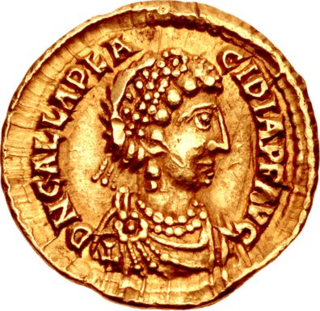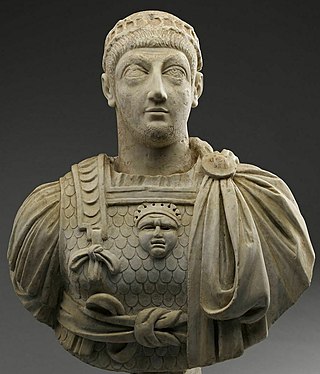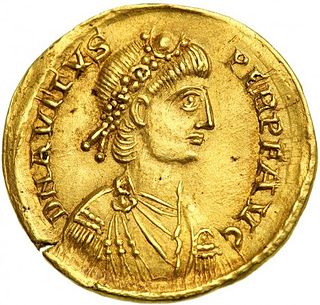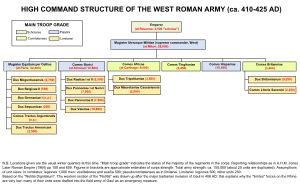
Galla Placidia, daughter of the Roman emperor Theodosius I, was a mother, tutor, and advisor to emperor Valentinian III. She was queen consort to Ataulf, king of the Visigoths from 414 until his death in 415, briefly empress consort to Constantius III in 421, and managed the government administration as a regent during the early reign of Valentinian III until her death.
The 440s decade ran from January 1, 440, to December 31, 449.

Anicius Olybrius was Roman emperor from July 472 until his death later that same year; his rule as augustus in the western Roman Empire was not recognised as legitimate by the ruling augustus in the eastern Roman Empire, Leo I. He was in reality a puppet ruler raised to power by Ricimer, the magister militum of Germanic descent, and was mainly interested in religion, while the actual power was held by Ricimer and his nephew Gundobad.

Valentinian III was Roman emperor in the West from 425 to 455. Made emperor in childhood, his reign over the Roman Empire was one of the longest, but was dominated by powerful generals vying for power amid civil wars and the invasions of Late antiquity's Migration Period, including the campaigns of Attila the Hun.

Flavius Aetius was a Roman general and statesman of the closing period of the Western Roman Empire. He was a military commander and the most influential man in the Empire for two decades (433–454). He managed policy in regard to the attacks of barbarian federates settled throughout the West. Notably, he mustered a large Roman and allied (foederati) army in the Battle of the Catalaunian Plains, ending a devastating invasion of Gaul by Attila in 451, though the Hun and his subjugated allies still managed to invade Italy the following year, an incursion best remembered for the ruthless Sack of Aquileia and the intercession of Pope Leo I.

Eparchius Avitus was Roman emperor of the Western Empire from July 455 to October 456. He was a senator of Gallic extraction and a high-ranking officer both in the civil and military administration, as well as Bishop of Piacenza.

The term Western Roman Empire is used in modern historiography to refer to the western provinces of the Roman Empire, collectively, during any period in which they were administered separately from the eastern provinces by a separate, independent imperial court. Particularly during the period from AD 395 to 476, there were separate, coequal courts dividing the governance of the empire into the Western provinces and the Eastern provinces with a distinct imperial succession in the separate courts. The terms Western Roman Empire and Eastern Roman Empire were coined in modern times to describe political entities that were de facto independent; contemporary Romans did not consider the Empire to have been split into two empires but viewed it as a single polity governed by two imperial courts for administrative expediency. The Western Empire collapsed in 476, and the Western imperial court in Ravenna disappeared by AD 554, at the end of Justinian's Gothic War.

The Theodosian dynasty was a Roman imperial family that produced five Roman emperors during Late Antiquity, reigning over the Roman Empire from 379 to 457. The dynasty's patriarch was Theodosius the Elder, whose son Theodosius the Great was made Roman emperor in 379. Theodosius's two sons both became emperors, while his daughter married Constantius III, producing a daughter that became an empress and a son also became emperor. The dynasty of Theodosius married into, and reigned concurrently with, the ruling Valentinianic dynasty, and was succeeded by the Leonid dynasty with the accession of Leo the Great.

The Valentinian dynasty was a ruling house of five generations of dynasts, including five Roman emperors during late antiquity, lasting nearly a hundred years from the mid fourth to the mid fifth century. They succeeded the Constantinian dynasty and reigned over the Roman Empire from 364 to 392 and from 425 to 455, with an interregnum (392–423), during which the Theodosian dynasty ruled and eventually succeeded them. The Theodosians, who intermarried into the Valentinian house, ruled concurrently in the east after 379.
Flavius Richomeres or Ricomer was a Frank who lived in the late 4th century. He took service in the Roman army and made a career as comes, magister militum, and consul. He was an uncle of the general Arbogastes. He is possibly to be identified with the Richomeres who married Ascyla, whose son Theodemer later became king of the Franks.

Marcellinus was a Roman general and patrician who ruled over the region of Dalmatia in the Western Roman Empire and held sway with the army there from 454 until his death. Governing Dalmatia both independently from, and under, six Emperors during the twilight of the Western Empire, Marcellinus proved to be an able administrator and military personality with sources making reference that he ruled justly and well and kept Dalmatia independent of the emperor and of barbarian rulers.

The Praetorian Prefecture of Africa was an administrative division of the Byzantine Empire in the Maghreb. With its seat at Carthage, it was established after the reconquest of northwestern Africa from the Vandals in 533–534 by the Byzantine Emperor Justinian I. It continued to exist until 591, when it was replaced by the Exarchate of Africa.

The Anastasian War was fought from 502 to 506 between the Byzantine Empire and the Sasanian Empire. It was the first major conflict between the two powers since 440, and would be the prelude to a long series of destructive conflicts between the two empires over the next century.
Varanes was a politician and general of the Western and Eastern Roman Empires.
Flavius Patricius was a prominent Eastern Roman general and statesman during the reign of Byzantine emperor Anastasius I.
Flavius Timasius was a general of the Roman Empire, a relative of the Empress Aelia Flaccilla, wife of Emperor Theodosius I.
Athanasius was a 6th-century Byzantine official who served as envoy and praetorian prefect of Italy and Africa under Emperor Justinian I.
Flavius Arintheus was a Roman army officer who started his career in the middle ranks and rose to senior political and military positions. He served the emperors Constantius II, Julian, Jovian and Valens. In 372 he was appointed consul, alongside Domitius Modestus.
Dagalaifus was a Roman army officer of Germanic descent. A pagan, he served as consul in 366. In the year 361, he was appointed by Emperor Julian as comes domesticorum. He accompanied Julian on his march through Illyricum to quell what remained of the government of Constantius II that year. He led a party into Sirmium that arrested the commander of the resisting army, Lucillianus. In the spring of 363, Dagalaifus was part of Julian's ultimately-disastrous invasion of Persia. On June 26, while still campaigning, Julian was killed in a skirmish. Dagalaifus, who had been with the rear guard, played an important role in the election of the next emperor. The council of military officers finally agreed on the new comes domesticorum, Jovian, to succeed Julian. Jovian was a Christian whose father Varronianus had himself once served as comes domesticorum.
Equitius, or Aequitius, was magister militum in Illyricum in the Roman Empire.













